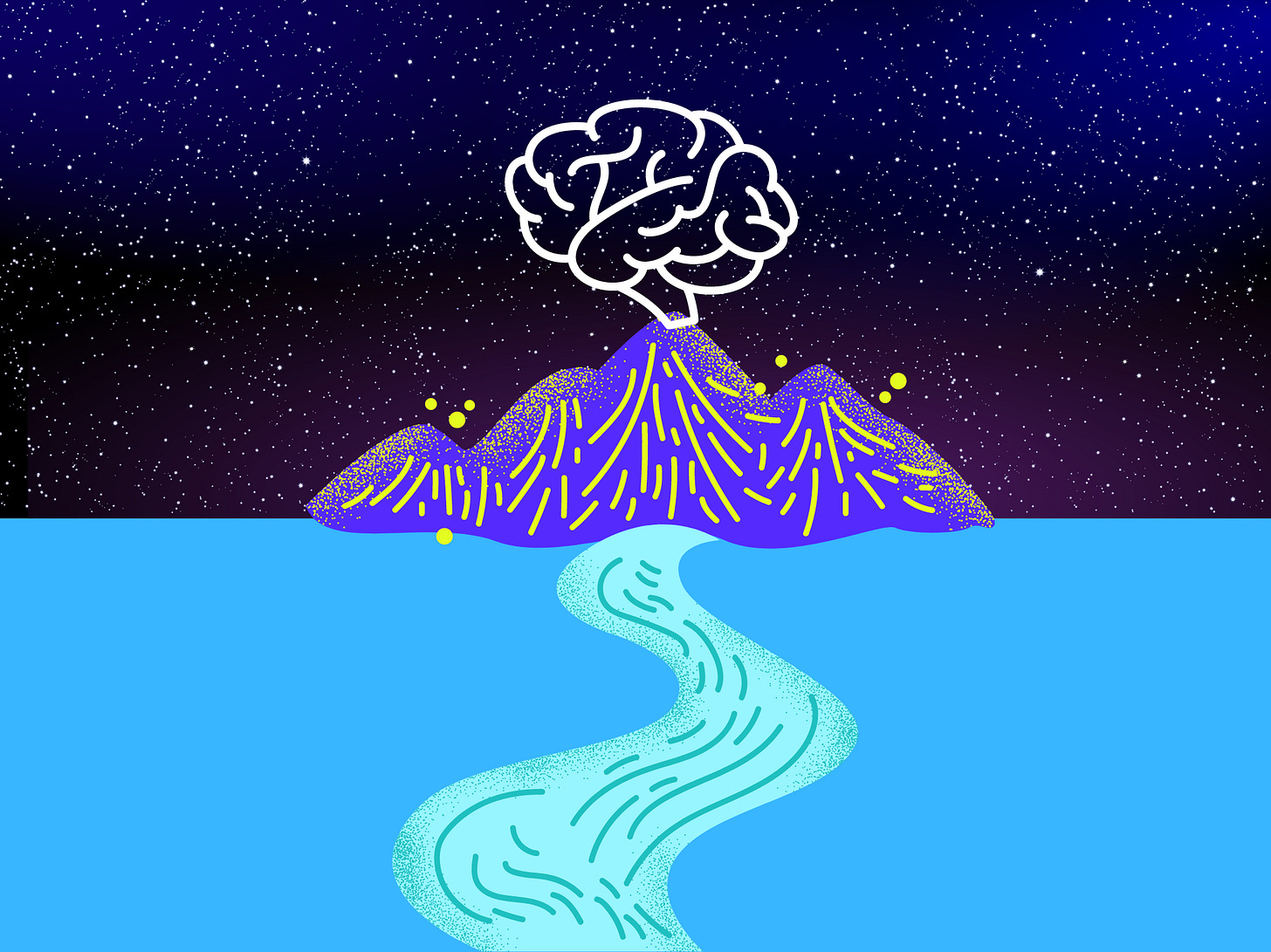Last Thursday, I picked up my phone 137 times and received 128 notifications. At some point, I must have worked. To work, I must have focused.
In a world of notifications, it can seem like focus is suffering a mass extinction event.
At work, 75% of Americans say that notifications kill their focus.
Just trying to find our focus, we have been turning to Adderall in higher numbers than ever: that’s why there’s a national Adderall shortage now.
The shortage is manufactured: the FDA identified the problem as one of demand, and cut supply accordingly. It’s a business move only the government could think is a solution.



Since 2020, prescriptions for Adderall grew by half a million. As Fortune puts it:
Roughly 16 million Americans used prescription stimulants including Adderall in 2017, according to the U.S. National Institutes of Health. That number rose even higher after the advent of the COVID pandemic.
Although prescriptions for people under the age of 21 remained fairly stable, the number of patients aged 22-44 with Adderall prescriptions jumped 7.4% between the second quarter of 2019 and the second quarter of 2020. It jumped another 15.1% the next year. Patients ages 45 and older only saw a small uptick in such prescriptions during the pandemic, according to Trilliant Health, a firm that provides market analytics to the healthcare industry.
Adderall is in demand, because more people are having a harder time focusing. In a notification culture, that focus is sickly at best and bedridden at worst.
Consider this:
In one report, developers said they only had time for ten hours, each week, of “deep work” (read: actual coding).
The average white collar worker is said to be productive for just two hours and forty-eight minutes a day.
On average, tech workers use eight different systems a day to do their jobs. That means a lot of switching, process management, and multi-tasking.
Trying to do more than one thing at once is the opposite of the flow state and yet to be “productive” at work or at school or at home requires the use of multiple devices, multiple browsers, multiple systems at almost every turn.
This is why we can’t focus.
As Quartz writes:
Gloria Mark, professor in the department of informatics at the University of California, Irvine, says that when people are interrupted, it typically takes 23 minutes and 15 seconds to return to their work, and most people will do two intervening tasks before going back to their original project. This switching leads to a build up of stress, she says, and so little wonder people who have high rates of neuroticism, impulsivity, and are susceptible to stress tend to switch tasks more than others.
How do we get back to being productive?
How do we access our flow state and find focus… even if we can’t find Adderall?
Marcel Proust had some ideas.
Within a Budding Worker
Marcel Proust, a French author considered to be one of the most influential writers of the twentieth century, was born in 1871. By the age of nine, after a terrible asthma attack, he started a life of almost incessant illness. Despite an unenviable constitution, he partied across Parisian salons instead of getting to work.
Proust was known, before the 1913 publication of [the first volume of In Search of Lost Time] “Swann’s Way,” as a malicious, amusing, slightly absurd society boy, with a vaguely pathetic literary hobby… A charming society hanger-on, he was admired by his close friends for his literary dedication and the extraordinary flow of his letters—which are effortlessly parenthetical, sliding into digression and back to the main point with the skill of a rally driver dipping in and out of traffic at a hundred miles an hour. None of them, however, thought him much more than a dilettante.
Let’s pause here. When talking about Hemingway earlier this month, we conjectured that many letters he wrote about training his cats were likely little more than the drunk texts of a Jazz Age.
Proust, who could never turn down a salon, should be seen here as someone whose focus was swallowed by the most image-obsessed social media there was: Parisian salons. Add the “extraordinary flow of his letters” to the mix and you’ve got someone who is texting, constantly, when not spending his time building his personal brand and looking for likes.
His partying reputation made it hard for people to take him - or his work - seriously. The New Yorker explains:
When the first volume of “In Search of Lost Time” appeared, a year before the Great War, the shock of its excellence was captured in a delicious exchange with André Gide, the magus of the Parisian literary scene. Apologizing for having passed on “Swann’s Way” for his Nouvelle Revue Française, Gide offered an explanation almost more insulting than the original rejection: “For me you were still the man who frequented the houses of Mmes X. and Z.”
Proust started his masterpiece in 1909 at the age of 38. A total of seven volumes spanning 3,000+ pages, In Search of Lost Time was completed, almost, in 1922 when Proust was 51. This was the last year of Proust’s life. What had spurred him to finally buckle down? He became so ill that he was confined to his bedroom for the last three years of his life. He wrote nearly every day until he died.
In isolation, finally free of salons and social circles, Proust found his focus.
But what advice does he have for the contemporary social media era?
In Within a Budding Grove, the second volume of Proust’s In Search of Lost Time, the narrator - a horny teenage aristocrat living through the Bella Epoch - reflects on how to get into the flow state when he spends time with a famed Impressionist painter by the name of Elstir.
Elstir shares three hacks for finding focus and actually doing deep work.
Here are three ways to find focus, according to Proust:
1. Find Your Day Dreams.
Elstir believes that day dreams lead to greatness. Within day dreams, Elstir finds inspiration for his paintings.
How can creators get inspiration? Break writer’s block? Unlock ideas?
It’s all about taking breaks.
As Elstir says:
If a little day-dreaming is dangerous, the cure for it is not to dream less but to dream more, to dream all the time.
As antithetical to hustle culture as this may seem, the best kind of science - data science - shows this to be true.
As Time reports:
Productivity app DeskTime lets employers see if their people are working or goofing around on Facebook or Buzzfeed. It sifted through the computer activity data of its 5.5 million daily logs to come up with the 10% most productive workers, then it took a peek at how they spend their time during the day.
The result: The most productive workers engage in job-related tasks for 52 minutes, then take a 17-minute break. That 15-to-20-minute window is productivity’s “golden hour” (or quarter-hour, as the case may be). It’s long enough for your brain to disengage and leave you feeling refreshed, but not so long that you lose focus and derail momentum on what you were doing.
Not all daydreams are created equal. Daniel Levitin, a professor of behavioral neuroscience at McGill University, tells Quartz:
These breaks must allow for mind-wandering, whether you’re walking, staring out the window, listening to music or reading.
“Everyone gets there a different way. But surfing Facebook is not one of them,” he says. Social networks just produce more fractured attention, as you flit from one thing to the next.
Remember how Proust wasted all his time writing letters and judging people at salons? That wasn’t relaxation. It was labor.
The same goes for social media today. Research shows that our brains interpret mobile devices as a source of labor. We get tired and bored when we use them, not inspired.
To daydream means to take a break from everything, not just the task at hand.
The trick is to know less, not more, to finally get focused. That can be hard, considering we live in world in which the average person has 10-20 open browser tabs at any given time.
Proust recognizes that great ideas and great work come from making yourself deliberately ignorant:
The effort made by Elstir to strip himself, when face to face with reality, of every intellectual concept, was all the more admirable in that this man who, before sitting down to paint, made himself deliberately ignorant, forgot, in his honesty of purpose, everything that he knew.
Most people spend roughly 1 minute 15 seconds on their phone once they pick it up. And we pick our phones up roughly every 1 hour and 43 minutes [every day].
From a lower-end estimate, this equates to losing 37.5 minutes a day during working hours to your smartphone.
We’re soothed and meditative with nothing in front of us. It’s hard to achieve that daydream state if you’re constantly checking your phone.
Also, make sure your phone is in another room.
According to Harvard Business Review, people perform better when their phones are out of sight.
2. FOMO Destroys Flow State.
Cabourg, Proust’s beachside resort town fictionalized as “Balbec”
The narrator of Within a Budding Grove spends much of his time at the beachside resort of Balbec. Whisked away for a summer on the beach with his grandmother, he hasn’t had too much female attention.
That all changes when he sees a group of beach babes and starts stalking them, perhaps in a gentlemanly way, each day. While spending time at Elstir’s studio, he sees one of these beauties out the window.
Elstir’s lessons about art and genius become an annoyance. Our adolescent narrator “scarcely” listens and reflects in frustration:
[Elstir] was no longer sufficient in himself, he was now only the necessary intermediary between girls and me; the prestige which, only a few moments ago, his talent had still given him in my eyes was now worthless save in so far as it might confer a little on me also in the eyes of the little band to whom I should be introduced by him.
All that genius talk?
Gone in the first tickle of fancy.
Elstir the painter? Now just Elstir the wingman.
Want to find focus?
Forget your fear of missing out on whatever else could, would, and may be happening.
It’s a distraction.
One in three adults say they experience FOMO regularly. But that’s only from a sense of competition, of unworthiness in the task at hand. Find the greatness in the work, and make the greatness work.

As Proust realizes, when we achieve the object of our longing, it becomes clear that the fear of missing out is nothing but the images we ourselves paint on mirrors:
We realise only too clearly that this acquisition puts an end for us to not merely hours of toilsome search - a relief that can only fill us with joy - but also to the existence of a certain person, the person whom our imagination had wildly distorted, whom our anxious fear that we might never become known to her had magnified… as when in a fairy tale the magician commands a person suddenly to become someone else.
In the eyes that only yesterday were situated at an infinite distance… the conscious gaze, the incommunicable thought which we were seeking have just been miraculously and quite simply replaced by our own image painted in them as in a smiling mirror.
Or, as F. Scott Fitzgerald would put it six years later in The Great Gatsby (1925), FOMO never lives up to the hype. Jay Gatsby found it out the hard way, as our narrator Nick Carroway observes:
His dream must have seemed so close that he could hardly fail to grasp it. He did not know that it was already behind him.
Want to focus?
Focus on what you can control. Don’t desire something you see out the window, whether the vision is in the metaverse or the meatverse.
To flow, forget FOMO.
3. Find Inspiration in the Present.
An over-stimulated culture consumes sensations like junk food. Sometimes, even as we know something amazing is happening, it can be hard to appreciate that appreciation. In other words, we take a lot of things for granted.
As Proust says:
Pleasures are like photographs: in the presence of the person we love, we take only negatives, which we develop later, at home, when we have at our disposal once more our inner dark room, the door of which it is strictly forbidden to open while others are present.
In Andrew Marantz’s superb essay about producer Jack Antonoff, Marantz admits the challenge of writing about music:
If writing about music is like dancing about architecture, then interviewing a musician can be like trying to tango with a block of concrete.
Proust’s prose, by simply dwelling on each moment of the experience, takes the challenge head-on. How can you describe the appreciation of the present and the inspiration it can bring?
Here’s Proust describing nobleman Charles Swann’s obsession with a song:
The little phrase, as soon as it struck his ear, had the power to liberate in him the room that was needed to contain it; the proportions of Swann’s soul were altered; a margin was left for an enjoyment that corresponded no more than his love for Odette to any external object and yet was not, like his enjoyment of that love, purely individual, but assumed for him a sort of reality superior to that of concrete things. This thirst for an unknown delight was awakened in him by the little phrase, but without bringing him any precise gratification to assuage it. With the result that those parts of Swann’s soul in which the little phrase had obliterated all concern for material interests, those human considerations which affect all men alike, were left vacant by it, blank pages on which he was at liberty to inscribe the name of Odette.”
Or, as we say today, “That song is catchy!”
It is Proust’s gift to articulate the process of perception. The power to live in the present is what creates original thought. Focus is a spirit, something to be summoned by living in the present.
As he talks with Elstir, our narrator doubles his pleasure as he looks out the window:
The intellectual pleasures which I was enjoying in this studio did not in the least prevent me from being aware, although they enveloped us as it were in spite of ourselves, of the warm glazes, the sparkling penumbra of the room itself and, through the little window framed with honeysuckle, in the rustic avenue, the resilient dryness of the sun-parched earth, veiled only by the diaphanous gauze woven of distance and the shade of trees. Perhaps the unconscious well-being induced by this summer day came like a tributary to swell the flood of joy that had surged in me at the sight of Elstir’s [painting] “Carquethuit Harbour.
By dwelling on one frame of beauty and truly feeling it, our narrator appreciates both artist and nature.
By focusing on the present instead of trying to imitate trends, originality is born:
It is rightly said that there can be no progress, no discovery in art, but only in the sciences, and that each artist starting afresh on an individual effort cannot be either helped or hindered therein by the efforts any other, it must none the less be acknowledged that, in so far as art brings out certain laws, once an industry that has taken those laws and popularised them, the art that was first in the field loses retrospectively a little of its originality.
The Toxicity of Awareness
Ultimately, Proust believes that to find your focus, you have to find your “honesty of purpose” and become ignorant:
For what one knows does not belong to oneself.
In an era of hyper-awareness, it’s hard to hyperfocus. But it’s not impossible.
Turn off your phone and leave it in another room.
Find the purpose of your daydreams.
Don’t let FOMO distract you.
Appreciate the flow state.
Good luck.




This post crystallized all the reasons I hate being asked to be responsive to staff emails mid-day. When I'm in the school building and have students either in my room or on my mind, I'd much rather think on their needs than fiddle about allaying admin's anxieties; that can come later. Even on prep and lunch, those 45 minutes of (mostly) unstructured time allow for some of the best thinking I do on any given day.
I have a sneaky feeling that what would really help me access my truest flow state is getting an open-top Jeep and going hog-hunting with Neal Stephenson and a AR-15 Bushmaster. Dare to daydream!